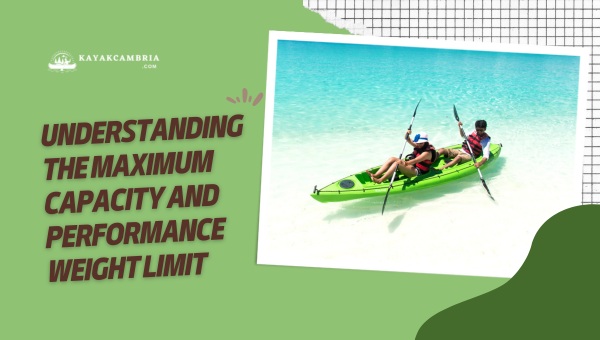As a kayaking enthusiast, I often get the question, is there a weight limit for a kayak? The answer isn’t as simple as a simple yes or no, as various factors come into play. Let me provide some clarity on this topic, as understanding weight limits is essential for safety and success on the water.
First, it’s essential to know that every kayak has a specific weight capacity, also known as the Maximum Capacity. This number is the total weight a kayak can safely handle, including the kayaker, gear, and any accessories. So, when asking if there is a weight limit for a kayak, the answer is yes, and it varies depending on the model and type of kayak.
When choosing a kayak, you should pay attention to the manufacturer’s specifications, which often include the suggested weight range. This information will help you select a suitable kayak that can safely accommodate your weight and load, ensuring a more enjoyable kayaking experience.
Contents
Contents
Understanding Kayak Weight Limits

In order to help you make the most of your kayaking adventures, let’s break down kayak weight limits and what you need to know before hitting the water.
First off, there is a weight limit for most kayaks – and it varies depending on the specific make and model. Manufacturers typically provide this information, often referred to as the Maximum Weight Capacity, directly on the kayak or in the product manual. This number indicates the maximum combined weight of the paddler, their gear, and any onboard cargo that the kayak can safely support. It’s crucial not to exceed this limit to avoid compromising the kayak’s stability, maneuverability, and overall performance.
The weight capacity may differ from one kayak to another due to differences in factors such as:
- Size: Generally, larger kayaks can hold more weight.
- Type: The weight capacity is often higher for tandem or fishing kayaks compared to recreational or whitewater kayaks.
- Material: High-quality materials like carbon fiber and high-density polyethylene can support more weight.
- Hull design: A flatter hull design offers more stability and a higher weight capacity, while a more rounded hull trades some capacity for better agility.
To make sure you have a safe and enjoyable kayaking experience, consider the following guidelines:
- Calculate your anticipated total load, including your body weight, gear, and any potential added cargo.
- Remember that the optimal performance of a kayak is usually achieved when the total load is around 75% of the maximum weight capacity.
- Adjust your load according to the type of kayaking you plan to do, whether it’s recreational, fishing, or whitewater.
- Extra gear, like fish finders, rod holders, or tackle boxes, also adds to the overall weight.
Types of Kayaks and Their Capacities

When it comes to kayaking, one question that frequently arises is, “Is there a weight limit for a kayak?” To answer this, let’s explore the different types of kayaks and their capacities. Keep in mind that these capacities vary depending on the kayak’s size, materials, and design.
1. Recreational Kayaks

Recreational kayaks are popular choices for beginners and those who enjoy kayaking in flat water environments such as lakes, ponds, or slow-moving rivers. These kayaks are typically stable, easy to maneuver, and have a wide range of weight capacities. Recreational kayaks’ capacities generally fall between 200 to 450 pounds. Some popular recreational kayak models and their weight capacities include:
- Old Town Vapor 10: 325 pounds
- Sun Dolphin Aruba 10: 250 pounds
- Perception Pescador 12: 375 pounds
2. Touring and Sea Kayaks

Touring and sea kayaks are designed for long-distance paddling and open water conditions. These kayaks are longer, and narrower, and often include storage compartments for multi-day trips. Weight capacities for touring and sea kayaks can vary greatly but often range from 275 to 500 pounds. Examples of touring and sea kayak weight capacities are:
- Wilderness Systems Tsunami 145: 350 pounds
- Perception Expression 14.5: 325 pounds
- Delta Kayaks 17: 410 pounds
3. Inflatable Kayaks

Inflatable kayaks are convenient options for those looking for portability and easy storage. Made from durable materials, these kayaks can handle a variety of water conditions and have a surprisingly high weight capacity. Inflatable kayak weight capacities can range from 250 to 600 pounds. Some well-known inflatable kayak models and their capacities include:
- Advanced Elements AdvancedFrame: 300 pounds
- Sea Eagle 370 Pro: 650 pounds
- Intex Explorer K2: 400 pounds
4. Tandem Kayaks

Tandem kayaks, also known as double kayaks, are designed to accommodate two paddlers. These kayaks have higher weight capacities than solo kayaks to account for the additional person and gear. Typical tandem kayak weight limits range between 450 to 700 pounds. Examples of tandem kayak capacities are:
- Ocean Kayak Malibu Two: 425 pounds
- Hobie Mirage Oasis: 550 pounds
- Wilderness Systems Pamlico 135T: 500 pounds
5. Sit-On-Top Kayaks

Sit-on-top kayaks are popular among beginners and warm-weather paddlers, as they offer excellent stability, easy entry and exit, and self-draining capabilities. These kayaks are suitable for recreational use in calm waters or for fishing purposes. Sit-on-top kayak weight capacities typically range from 250 to 550 pounds. Some well-known sit-on-top kayak models and their capacities include:
- Lifetime Tamarack Angler 100: 275 pounds
- Ocean Kayak Scrambler 11: 350 pounds
- Wilderness Systems Tarpon 120: 350 pounds
6. Fishing Kayaks

Fishing kayaks are specifically designed with anglers in mind, providing features such as rod holders, tackle storage compartments, and accessory mounts tailored to make the fishing experience more enjoyable. These kayaks can be either sit-inside or sit-on-top models but generally prioritize stability over speed due to the potential movement caused by casting or reeling in fish. Fishing kayak weight capacities typically vary between 250 to more than 600 pounds depending on the size of the model.
- Jackson Coosa HD: 425 pounds
- Old Town Predator PDL: 500 pounds
- Pelican Catch PWR100 Electric-Powered Fishing Kayak: Up to a total of approximately 612 lbs (278 kg), including both rider & gear capacity and battery/motor system weight
While there isn’t a universal weight limit for all kayaks, it’s essential to consider your specific kayak’s capacity before venturing out onto the water. It’s always advised to check the manufacturer’s recommendations for weight limits and adhere to those guidelines for performance and safety reasons.
Factoring in Gear and Equipment

It’s important to keep in mind the additional gear and equipment when considering the weight of the kayak that’ll be brought along. Depending on the activity, equipment weight can add up quickly and impact the overall weight capacity of your kayak. Here, I’ll discuss a few aspects to consider when factoring in gear and equipment for your kayaking adventures.
Firstly, think about the type of kayaking you’ll be doing. Different activities require different gear, and this will affect the total weight loaded onto your kayak. A few examples include:
- Recreational kayaking: Lifejackets, paddles, and lunch
- Fishing: Fishing tackle, bait, rods, and perhaps a cooler
- Camping: Tent, sleeping gear, cookware, and food
In addition to the type of kayaking activity, there’s the matter of personal gear. Some items that might add to the overall weight include:
- Clothing
- Protective gear (helmets, gloves, etc.)
- Electronic devices (phone, camera, GPS)
- Dry bags and storage containers
When researching the weight limit of a particular kayak, take a look at the manufacturer’s specifications. They’ll typically provide a weight capacity, which factors in the weight of the paddler and the gear combined. To determine whether you’re within this limit, you can combine your weight with the estimated weight of your gear and compare it to the kayak’s capacity.
To help with gear calculations, here’s a sample breakdown of weights for common kayaking equipment:
| Gear Item | Estimated Weight (lbs) |
| Lifejacket | 2-5 |
| Paddle | 1-4 |
| Fishing Tackle & Rods | 5-15 |
| Cooler | 5-15 |
| Camping Equipment (varies) | 15-40 |
| Personal Items | 2-15 |
Keep in mind that these are just rough estimates, and the actual weight of your equipment may differ. Allow yourself a safety buffer when calculating weight limits – it’s always better to underestimate the kayak’s capacity than to exceed it and risk capsizing or damaging your equipment.
Lastly, consider the distribution of weight in your kayak. It’s crucial to evenly distribute the weight of your gear, as imbalanced loads can negatively affect the kayak’s stability and performance. Make sure heavy items are centered while lighter items are stowed near the bow and stern.
Always factor in the weight of your gear and equipment when examining the weight limit for a kayak. By doing so, you’ll ensure a safer and more enjoyable kayaking experience.
Effect of Exceeding the Weight Limit

Understanding the implications of exceeding the kayak weight limit is essential for a safe and enjoyable experience on the water. In this section, I’ll discuss some of the consequences of going beyond the weight capacity of your kayak.
1. Reduced Stability
For starters, reduced stability is a notable issue when a kayak is overloaded. Here’s what happens:
- The kayak sits lower in the water, causing it to become less responsive
- A lower center of gravity increases the risk of tipping over
- With uneven weight distribution, the kayak may dip more on one side, further decreasing stability
2. Decreased Performance
Additionally, exceeding the weight limit can result in decreased performance. This includes:
- Slower speeds as the increased weight creates more resistance in the water
- Difficulty maneuvering due to the lower position in the water and reduced responsiveness
- Greater effort needed to paddle as the kayak moves against the additional drag
3. Increased Strain on the Kayak
Moreover, when you surpass the kayak’s capacity, you’re also putting increased strain on the kayak. Such strain can lead to:
- Structural damage or weakened support points, especially in lower-quality or older kayaks
- Potential leaks due to additional pressure on the seams, leading to water infiltration
- Less durability, ultimately decreasing the lifespan of the kayak
Lastly, safety concerns emerge when a kayak’s load surpasses its maximum capacity:
- In case of capsize, rescue or re-entry becomes more difficult
- A swamped kayak might not be able to float as effectively, increasing the risk of sinking
- Reduced visibility to surrounding boaters as the kayak sits lower in the water
So, while the impact of exceeding the weight limit might not be immediate, the potential consequences cannot be ignored. Always consult the manufacturer’s guidelines for their recommended weight capacities and take them seriously. Understanding these limitations helps ensure not only an enjoyable kayaking experience but more importantly, a safe one.
Understanding the Maximum Capacity and Performance Weight Limit

A kayak’s maximum weight capacity refers to the total weight it can sustain without sinking, whereas the performance weight limit relates to the weight it can carry while still maintaining efficient performance on the water.
The suggested maximum capacity for most kayaks typically ranges from 250-450 pounds, although some larger kayaks may carry up to 600 pounds. It is essential to mention that this maximum capacity includes not just the paddler’s weight but also that of their gears, clothes, and all other personal belongings.
However, carrying the maximum capacity may affect the handling and stability of the kayak, making it difficult to paddle smoothly. To have the best possible paddling experience, it is recommended to adhere to the performance weight limit, which typically is around 70% of the maximum weight capacity. This is where our simple formula comes in.
Calculating the Kayak Weight Limit
Now, let’s dive into how to calculate the weight limit of a kayak with our two-step formula:
- Maximum Weight Capacity: Total Load Requirement / 0.7
- Performance Weight Limit: Maximum Weight Capacity × 0.7
First, we need to know the Total Load Requirement, which means the ideal weight a kayak should carry, including the paddler and its gears. To calculate your kayak’s Maximum Weight Capacity, divide this Total Load Requirement by 0.7.
Second, to determine the Performance Weight Limit, simply multiply the Maximum Weight Capacity by 0.7. Staying within the Performance Weight Limit will ensure optimal performance and stability while kayaking.
For example, if the Total Load Requirement is 300 pounds, here is how the weight limit calculation will look:
- Maximum Weight Capacity = 300 / 0.7 = 428.57 pounds
- Performance Weight Limit = 428.57 × 0.7 = 300 pounds
In Conclusion
When it comes to the question “Is there a weight limit for a kayak,” the answer is a definite yes. Kayaks do have weight limits, and understanding these limits is crucial for both safety and performance. Throughout this article, I’ve covered various factors that determine the weight limit, such as the kayak’s material, design, and type. To recap, here are some key aspects to remember:
- Weight limits for kayaks can vary widely, ranging from about 200 pounds for small recreational kayaks to upwards of 600 pounds for larger tandem models.
- It’s essential to consider your weight along with your gear’s weight when calculating if you’re within a kayak’s recommended limit.
- Exceeding a kayak’s weight limit can lead to issues with stability, maneuverability, and even potential capsizing.
To ensure you’re making the safest and most enjoyable kayaking experience, remember:
- Always confirm the kayak’s specific weight limit by checking the manufacturer’s guidelines.
- Adjust your kayak’s setup, such as seat position and foot pegs, to accommodate for differences in weight distribution.
- Be mindful of any additional gear you’ll be carrying, and factor that into the kayak’s weight limit.
- Practice good kayaking safety by wearing a personal flotation device and understanding your limitations.
Staying within your kayak’s weight limit not only ensures a safe paddling experience, but it also guarantees optimal kayak performance. Armed with this knowledge, I hope you’ll find the perfect kayak for your needs and enjoy your time out on the water.

